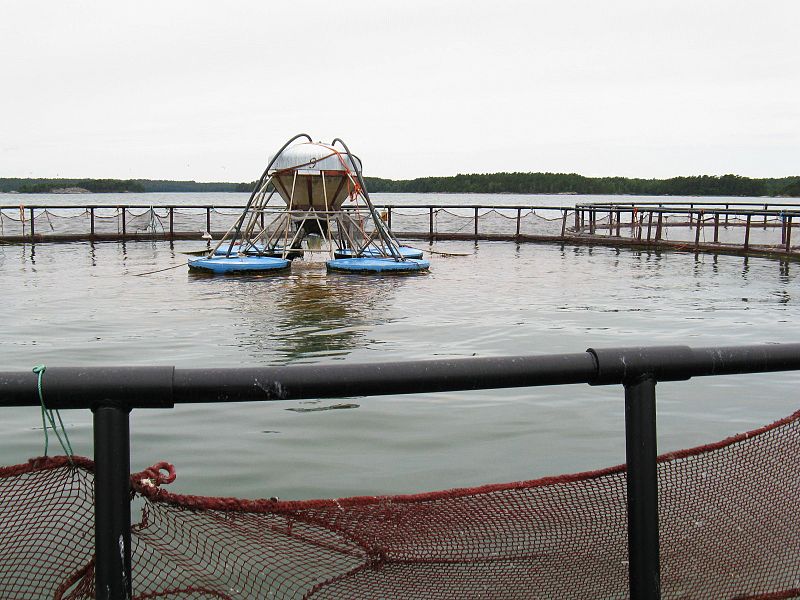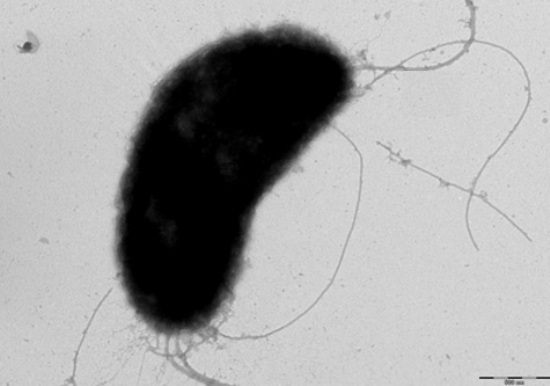Where Can You Find Vibrio salmonicida?
The bacteria Vibrio Salmonicida lives in one of the more unusual environments compared to most bacteria. Their general habitat is a marine environment (Farmer III and Hickman-Brenner, 1991), but they are most commonly found in marine environments below 10°C (Bjelland et al. 2012 b). Water temperatures are only this low during winter and early spring months, causing the bacteria's disease to only be a threat during these months (Bjelland et al. 2012 b). Bacterial concentrations in the water can range from 12-43 bacteria/mL, and this bacteria is detected in a wider range of fish farms during the winter months (Enger et al. 1991). Other organisms that live in this cold climate are harp seals, blue whales, beluga whales, polar bears, and sea otters, to name a few.
 Though Vibrio salmonicida can survive for a significant
amount of time in water independently, most of their lives
are spent within the anatomy of a fish. Vibrio salmonicida causes a fatal
disease commonly known as Cold-water Vibrosis (Farmer III and
Hickman-Brenner, 1991). This quick-acting disease most commonly infects Atlantic salmon, but can also be found in rainbow trout and
Atlantic cod,
which are all commonly found in fish farms (Farmer III and Hickman-Brenner,
1991). Fish
affected by this disease usually live in Norway, Scotland, or
Canada. Although they are not limited to these areas, this is where fish farms have reported
the most significant amount of infection (Bruno 1996).
Advances have been made in the vaccine to fight this
disease, so now it is not as big of a threat to fish farms as it once was (Bjelland
et al.
2012 a). Despite this, however, research is still being done to find more
information about this changing bacterium.
Though Vibrio salmonicida can survive for a significant
amount of time in water independently, most of their lives
are spent within the anatomy of a fish. Vibrio salmonicida causes a fatal
disease commonly known as Cold-water Vibrosis (Farmer III and
Hickman-Brenner, 1991). This quick-acting disease most commonly infects Atlantic salmon, but can also be found in rainbow trout and
Atlantic cod,
which are all commonly found in fish farms (Farmer III and Hickman-Brenner,
1991). Fish
affected by this disease usually live in Norway, Scotland, or
Canada. Although they are not limited to these areas, this is where fish farms have reported
the most significant amount of infection (Bruno 1996).
Advances have been made in the vaccine to fight this
disease, so now it is not as big of a threat to fish farms as it once was (Bjelland
et al.
2012 a). Despite this, however, research is still being done to find more
information about this changing bacterium.

This infectious bacteria first enters the fish by the blood
stream. It travels to the internal organs, where it multiplies and
sets up a "home base." After the infection has become widespread, it takes
control of the blood stream (Farmer
III and Hickman-Brenner, 1991). More specifically, it attacks the
abdominal organs such as the kidneys, abdominal fat, spleen, and
cecum. The fish dies from anemia: a lack of viable red blood cells (Bruno
1996). It is currently unknown where this bacterium enters the fish,
but there is much speculation that it is through the gills (Bjelland
et al.
2012 a). An example of a much larger organism that attacks a
host's blood stream is the
medicinal leech.
The water which the host lives in is not only important for transportation of the bacteria into its host, but also for the livelihood of Vibrio salmonicida. A recent study done by Ane Bjelland (2012) investigated the effects of salt water on the success of this bacterial infection. Control fish were placed in both salt water and fresh water environments. Both were manually infected with Vibrio salmonicida. Results showed that the diseased fish in salt water had a significantly higher population of bacterial infection than those in fresh water. This implies that the bacterium relies on the salinity of its marine environment to successfully infect (Bjelland et al. 2012 a).
Learn more about the Adaptations of Vibrio salmonicida and how it affects this relationship or go to the Home Page.
See References.
